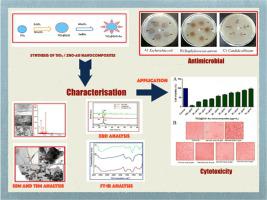当前位置:
X-MOL 学术
›
Inorg. Chem. Commun.
›
论文详情
Our official English website, www.x-mol.net, welcomes your feedback! (Note: you will need to create a separate account there.)
TiO2@ZnO nanocomposites decorated with gold nanoparticles: Synthesis, characterization and their antifungal, antibacterial, anti-inflammatory and anticancer activities
Inorganic Chemistry Communications ( IF 3.8 ) Pub Date : 2020-11-01 , DOI: 10.1016/j.inoche.2020.108210 Chelliah Pragathiswaran , Chinnasamy Smitha , Hamed Barabadi , Mysoon M. Al-Ansari , Latifah A. Al-Humaid , Muthupandian Saravanan
Inorganic Chemistry Communications ( IF 3.8 ) Pub Date : 2020-11-01 , DOI: 10.1016/j.inoche.2020.108210 Chelliah Pragathiswaran , Chinnasamy Smitha , Hamed Barabadi , Mysoon M. Al-Ansari , Latifah A. Al-Humaid , Muthupandian Saravanan

|
Abstract Nanocomposite synthesis is of great interest because of their wide variety of applications in various industries. In the current investigation, the nano-sized composites of TiO2 and ZnO (TiO2@ZnO) were prepared. The prepared TiO2@ZnO nanocomposites were modified by decorating gold nanoparticles (AuNPs) (TiO2@ZnO–Au) using a hydrothermal method. Field Emission Scanning Electron Microscope (FESEM), Transmission Electron Microscope (TEM), and Energy Dispersive X-ray spectroscopy (EDX) characterized the TiO2@ZnO – Au nanocomposites. The nanomaterial group study was carried out with FT-IR spectroscopy. Then, the synthesized TiO2@ZnO–Au nanocomposites were studied for their biological applications including antifungal, antibacterial, anti-inflammatory and anticancer activities. Interestingly, TiO2@ZnO-Au nanocomposites exhibited significant antimicrobial activity towards Escherichia- coli (MTCC 25922), Staphylococcus - aureus (MTCC 25923), and Candida- albicans (MTCC 282) by in vitro process. Besides, the nanocomposites represented remarkable anti-inflammatory activity using in vitro assays including albumin denaturation inhibitory assay, proteinase inhibitory assay, and heat induced hemolysis assay. Moreover, the prepared TiO2@ZnO–Au nanocomposites exhibited significant anticancer activity towards MCF 7 cells use an IC -50 value of 59.45 μg / mL through in vitro cytotoxicity assay using MTT assay. Future studies are required to show the effective biological activity of TiO2@ZnO–Au nanocomposites through in vitro model.
中文翻译:

金纳米粒子装饰的 TiO2@ZnO 纳米复合材料:合成、表征及其抗真菌、抗菌、抗炎和抗癌活性
摘要 纳米复合材料的合成因其在各个行业中的广泛应用而备受关注。在目前的研究中,制备了 TiO2 和 ZnO 的纳米级复合材料(TiO2@ZnO)。通过使用水热法装饰金纳米粒子 (AuNPs) (TiO2@ZnO-Au) 来修饰制备的 TiO2@ZnO 纳米复合材料。场发射扫描电子显微镜 (FESEM)、透射电子显微镜 (TEM) 和能量色散 X 射线光谱 (EDX) 表征了 TiO2@ZnO - Au 纳米复合材料。纳米材料组研究是用 FT-IR 光谱进行的。然后,研究了合成的 TiO2@ZnO-Au 纳米复合材料的生物学应用,包括抗真菌、抗菌、抗炎和抗癌活性。有趣的是,TiO2@ZnO-Au 纳米复合材料通过体外过程对大肠杆菌(MTCC 25922)、金黄色葡萄球菌(MTCC 25923)和白色念珠菌(MTCC 282)表现出显着的抗菌活性。此外,纳米复合材料在体外试验中表现出显着的抗炎活性,包括白蛋白变性抑制试验、蛋白酶抑制试验和热诱导溶血试验。此外,制备的 TiO2@ZnO-Au 纳米复合材料对 MCF 7 细胞表现出显着的抗癌活性,通过使用 MTT 测定的体外细胞毒性测定,IC -50 值为 59.45 μg/mL。未来的研究需要通过体外模型来展示 TiO2@ZnO-Au 纳米复合材料的有效生物活性。和白色念珠菌 (MTCC 282) 通过体外过程。此外,纳米复合材料在体外试验中表现出显着的抗炎活性,包括白蛋白变性抑制试验、蛋白酶抑制试验和热诱导溶血试验。此外,制备的 TiO2@ZnO-Au 纳米复合材料对 MCF 7 细胞表现出显着的抗癌活性,通过使用 MTT 测定的体外细胞毒性测定,IC -50 值为 59.45 μg/mL。未来的研究需要通过体外模型来展示 TiO2@ZnO-Au 纳米复合材料的有效生物活性。和白色念珠菌 (MTCC 282) 通过体外过程。此外,纳米复合材料在体外试验中表现出显着的抗炎活性,包括白蛋白变性抑制试验、蛋白酶抑制试验和热诱导溶血试验。此外,制备的 TiO2@ZnO-Au 纳米复合材料对 MCF 7 细胞表现出显着的抗癌活性,通过使用 MTT 测定的体外细胞毒性测定,IC -50 值为 59.45 μg/mL。未来的研究需要通过体外模型来展示 TiO2@ZnO-Au 纳米复合材料的有效生物活性。制备的 TiO2@ZnO-Au 纳米复合材料对 MCF 7 细胞表现出显着的抗癌活性,通过使用 MTT 测定的体外细胞毒性测定,IC -50 值为 59.45 μg/mL。未来的研究需要通过体外模型来展示 TiO2@ZnO-Au 纳米复合材料的有效生物活性。制备的 TiO2@ZnO-Au 纳米复合材料对 MCF 7 细胞表现出显着的抗癌活性,通过使用 MTT 测定的体外细胞毒性测定,IC -50 值为 59.45 μg/mL。未来的研究需要通过体外模型来展示 TiO2@ZnO-Au 纳米复合材料的有效生物活性。
更新日期:2020-11-01
中文翻译:

金纳米粒子装饰的 TiO2@ZnO 纳米复合材料:合成、表征及其抗真菌、抗菌、抗炎和抗癌活性
摘要 纳米复合材料的合成因其在各个行业中的广泛应用而备受关注。在目前的研究中,制备了 TiO2 和 ZnO 的纳米级复合材料(TiO2@ZnO)。通过使用水热法装饰金纳米粒子 (AuNPs) (TiO2@ZnO-Au) 来修饰制备的 TiO2@ZnO 纳米复合材料。场发射扫描电子显微镜 (FESEM)、透射电子显微镜 (TEM) 和能量色散 X 射线光谱 (EDX) 表征了 TiO2@ZnO - Au 纳米复合材料。纳米材料组研究是用 FT-IR 光谱进行的。然后,研究了合成的 TiO2@ZnO-Au 纳米复合材料的生物学应用,包括抗真菌、抗菌、抗炎和抗癌活性。有趣的是,TiO2@ZnO-Au 纳米复合材料通过体外过程对大肠杆菌(MTCC 25922)、金黄色葡萄球菌(MTCC 25923)和白色念珠菌(MTCC 282)表现出显着的抗菌活性。此外,纳米复合材料在体外试验中表现出显着的抗炎活性,包括白蛋白变性抑制试验、蛋白酶抑制试验和热诱导溶血试验。此外,制备的 TiO2@ZnO-Au 纳米复合材料对 MCF 7 细胞表现出显着的抗癌活性,通过使用 MTT 测定的体外细胞毒性测定,IC -50 值为 59.45 μg/mL。未来的研究需要通过体外模型来展示 TiO2@ZnO-Au 纳米复合材料的有效生物活性。和白色念珠菌 (MTCC 282) 通过体外过程。此外,纳米复合材料在体外试验中表现出显着的抗炎活性,包括白蛋白变性抑制试验、蛋白酶抑制试验和热诱导溶血试验。此外,制备的 TiO2@ZnO-Au 纳米复合材料对 MCF 7 细胞表现出显着的抗癌活性,通过使用 MTT 测定的体外细胞毒性测定,IC -50 值为 59.45 μg/mL。未来的研究需要通过体外模型来展示 TiO2@ZnO-Au 纳米复合材料的有效生物活性。和白色念珠菌 (MTCC 282) 通过体外过程。此外,纳米复合材料在体外试验中表现出显着的抗炎活性,包括白蛋白变性抑制试验、蛋白酶抑制试验和热诱导溶血试验。此外,制备的 TiO2@ZnO-Au 纳米复合材料对 MCF 7 细胞表现出显着的抗癌活性,通过使用 MTT 测定的体外细胞毒性测定,IC -50 值为 59.45 μg/mL。未来的研究需要通过体外模型来展示 TiO2@ZnO-Au 纳米复合材料的有效生物活性。制备的 TiO2@ZnO-Au 纳米复合材料对 MCF 7 细胞表现出显着的抗癌活性,通过使用 MTT 测定的体外细胞毒性测定,IC -50 值为 59.45 μg/mL。未来的研究需要通过体外模型来展示 TiO2@ZnO-Au 纳米复合材料的有效生物活性。制备的 TiO2@ZnO-Au 纳米复合材料对 MCF 7 细胞表现出显着的抗癌活性,通过使用 MTT 测定的体外细胞毒性测定,IC -50 值为 59.45 μg/mL。未来的研究需要通过体外模型来展示 TiO2@ZnO-Au 纳米复合材料的有效生物活性。


























 京公网安备 11010802027423号
京公网安备 11010802027423号